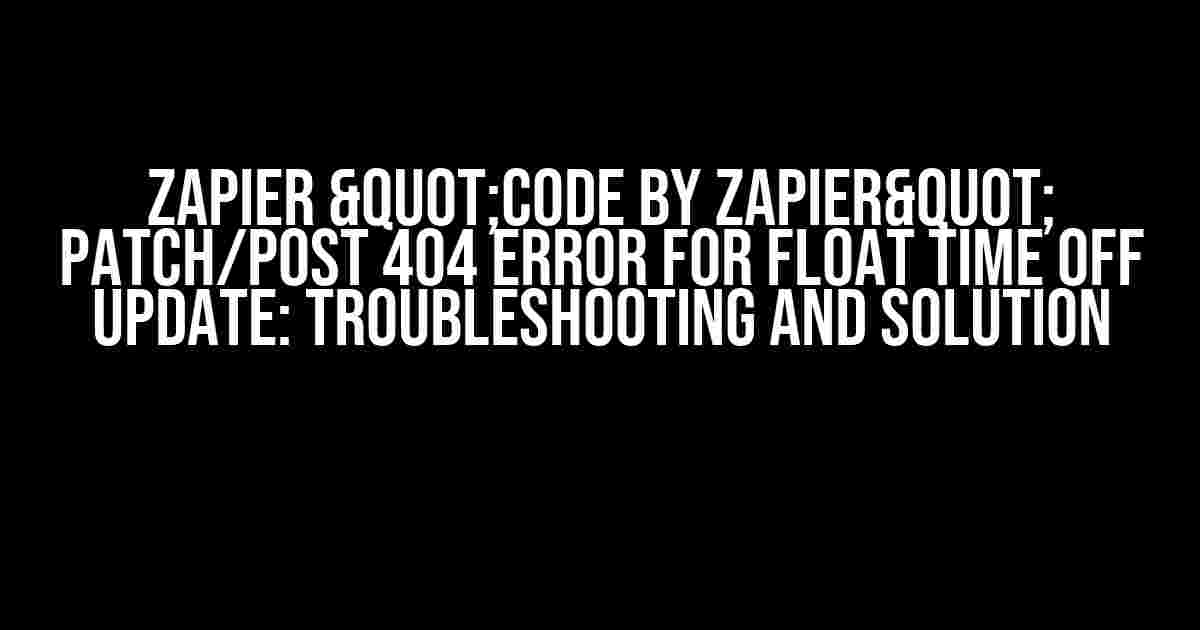Are you frustrated with the 404 error that keeps popping up when trying to update FLOAT time off using Zapier’s “Code by Zapier” feature? You’re not alone! In this article, we’ll dive into the world of Zapier and FLOAT integrations, exploring the common causes of this error and providing a step-by-step guide to resolve it.
Understanding the Error
The 404 error, also known as the “Not Found” error, occurs when Zapier’s “Code by Zapier” feature tries to access a non-existent or restricted resource. In the context of FLOAT time off updates, this error can be triggered by various factors, including:
- Incorrect FLOAT API credentials or permissions
- Invalid or missing FLOAT time off IDs
- Misconfigured Zapier “Code by Zapier” settings
- RATE LIMITING issues with FLOAT API
Diagnosing the Issue: Error Messages and Logs
Before we dive into the solution, let’s take a closer look at the error messages and logs that can help us diagnose the issue. When you encounter a 404 error, check the Zapier error log for the following messages:
{
"status": 404,
"statusCode": 404,
"headers": {
"content-type": "application/json; charset=utf-8"
},
"body": {
"error": {
"message": "Not Found",
"type": "invalid_request_error",
"param": null,
"code": null
}
}
}
Note the “message” and “type” fields, which can provide valuable insights into the nature of the error. In this case, the “Not Found” message and “invalid_request_error” type suggest that the issue lies with the request itself.
Troubleshooting and Solution
Now that we’ve identified the potential causes and error messages, let’s get into the troubleshooting and solution process. Follow these steps to resolve the 404 error and successfully update FLOAT time off using Zapier’s “Code by Zapier” feature:
-
Verify FLOAT API Credentials and Permissions
Double-check your FLOAT API credentials, ensuring that they are correct and have the necessary permissions to update time off. You can do this by:
- Logging into your FLOAT account and checking the API credentials
- Verifying that the API key has the required permissions (e.g., “time_off:write”)
-
Validate FLOAT Time Off IDs
Ensure that you’re using the correct FLOAT time off IDs in your Zapier “Code by Zapier” setup. You can do this by:
- Retrieving the time off ID from the FLOAT API or the FLOAT dashboard
- Verifying that the ID is correctly formatted and matches the FLOAT API documentation
-
Misconfigured Zapier “Code by Zapier” Settings
Review your Zapier “Code by Zapier” settings to ensure that they’re correctly configured. Check the following:
- The API endpoint URL is correct and properly formatted
- The API method is set to PATCH or POST, depending on the FLOAT API documentation
- The request headers and body are correct and match the FLOAT API documentation
Setting Value API Endpoint URL https://api.float.com/v1/time_off/[:id]API Method PATCHRequest Headers
{
"Authorization": "Bearer YOUR_API_KEY",
"Content-Type": "application/json"
}
Request Body
{
"time_off": {
"id": ":id",
"status": "approved"
}
}
-
RATE LIMITING Issues with FLOAT API
If you’re experiencing RATE LIMITING issues with the FLOAT API, consider the following:
- Implementing a retry mechanism in your Zapier “Code by Zapier” setup
- Optimizing your API requests to reduce the number of calls
- Contacting FLOAT support to request a rate limit increase
Conclusion
Resolving the 404 error when updating FLOAT time off using Zapier’s “Code by Zapier” feature requires a systematic approach to troubleshooting and a deep understanding of the FLOAT API and Zapier configurations. By following the steps outlined in this article, you should be able to identify and fix the underlying issue, ensuring that your FLOAT time off updates are successful and seamless.
Remember to stay vigilant and monitor your Zapier logs for any errors or warnings, as they can provide valuable insights into potential issues. With the right approach and a little patience, you’ll be able to overcome the 404 error and automate your FLOAT time off updates with ease.
Frequently Asked Questions
Get answers to the most common questions about resolving the 404 error when using “Code by Zapier” for FLOAT time off updates
Why am I getting a 404 error when updating FLOAT time off using “Code by Zapier”?
This error usually occurs when the API endpoint or the request URL is incorrect. Double-check that you’re using the correct FLOAT API endpoint and that the request URL is properly formatted. Make sure to include the required parameters and headers in your request.
How do I troubleshoot the 404 error in my “Code by Zapier” PATCH/POST request?
To troubleshoot the error, try the following steps: 1) Verify the API endpoint and request URL, 2) Check the request headers and parameters, 3) Test the request using a tool like Postman or cURL, and 4) Review the FLOAT API documentation to ensure you’re following the correct syntax and format.
What are the required headers and parameters for a successful FLOAT time off update using “Code by Zapier”?
The required headers and parameters may vary depending on your FLOAT API setup, but common ones include the API key, content-type, and Accept headers. You’ll also need to include the time off ID, employee ID, and other relevant details in the request body. Refer to the FLOAT API documentation for specific requirements.
Can I use the “Code by Zapier” editor to debug and test my PATCH/POST request?
Yes, you can use the “Code by Zapier” editor to debug and test your request. The editor provides features like code completion, error detection, and a console for logging and debugging. You can also use the editor to test your request and view the response to identify any issues.
What are some common causes of the 404 error in FLOAT time off updates using “Code by Zapier”?
Common causes of the 404 error include incorrect API endpoint or request URL, invalid API key or authentication, missing or incorrect request headers or parameters, and invalid or malformed request body. Additionally, issues with FLOAT API configuration, employee or time off ID mismatch, or permission restrictions can also cause the error.

